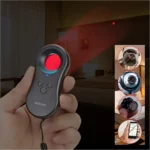Feeling safe and secure at home is a top priority for both renters and landlords. Apartment buildings present unique security challenges with shared access that require proactive measures to protect resident
Enhancing security is crucial for maintaining the quality of life for apartment renters while also protecting the value of the property for landlords and owners. The need for security applies to apartment buildings both large and small.
Effective apartment security provides numerous benefits such as:
- Reduced risk of break-ins and property theft
- Preventing unauthorized access by strangers
- Quickly detecting and resolving issues
- Increased sense of safety and comfort for residents
- Lower insurance costs due to reduced risks
- Avoiding reputation loss and occupancy impacts of crimes
By assessing risks, installing security systems, securing access points, educating tenants, and monitoring regularly, apartment buildings can achieve significantly higher security.

Conduct a Security Risk Assessment
The first step when evaluating your apartment security is conducting a thorough risk assessment. A security expert can identify weaknesses, problem areas, and necessary improvements tailored to your specific property.
Key elements of an apartment security risk assessment include:
Analyzing entry points
Assess all entrances including main lobby doors, parking garage access, fire exits, freight elevators, and package delivery areas.
Reviewing locks and lighting
Inspect the quality, functionality, and placement of all lighting fixtures and locks throughout the property.

Identifying isolated areas
Evaluate secluded areas like stairwells, storage rooms, and parking areas where enhanced security may be needed.
Observing operating procedures
Note practices for admitting visitors, receiving deliveries, and responding to incidents that could be improved.
Interviewing tenants
Get feedback from residents on where they feel unsafe and their ideas for improvements.
Pinpointing vulnerable areas through a professional risk assessment informs where to prioritize security upgrades for optimal impact.
Install Lighting
Proper lighting is one of the simplest deterrents for improving apartment security. Adequate illumination leaves criminals with nowhere to hide while also helping residents feel safe.
Install exterior lighting
Brightly light all entrances, parking areas, pathways, and perimeter areas, leaving no dark spots for criminals to lurk.
Add motion sensor lighting
Motion-activated lights surprise intruders, drawing attention to their presence when entering darkened areas.
Use LED bulbs
LEDs provide maximum brightness with low energy use and long lifespan, reducing maintenance costs.
Check for burnouts
Conduct regular inspections to promptly replace any burned out bulbs or malfunctioning fixtures.
Prune foliage
Trim back trees and bushes that may be obstructing security lights or enabling concealed access.
Well-lit apartments eliminate the shadows and concealment that threats depend on. Bright, maintained lighting acts as an ever-present security guard.
Install or Update Video Surveillance Systems
Video surveillance systems are vital for monitoring apartment common areas, entry points, and perimeter parameter. Video footage also aids investigations of incidents.

Place cameras strategically
Cover key areas revealed by the risk assessment like lobbies, elevators, parking spots, package rooms, and laundry rooms.
Select high-resolution models
Choose camera models with high resolution and night vision capability for clear video and images in all conditions.
Use a digital video recorder (DVR)
A DVR securely saves footage from multiple cameras for retrieving and reviewing video evidence when needed.
Post signage
Signs notifying that the premises is under video surveillance deter crime while also reassuring residents.
Check systems regularly
Confirm cameras have not been obstructed or tampered with and are capturing usable footage.
Video surveillance acts as an extra set of eyes, providing visual verification of any security issues or incidents on the premises.
Secure All Doors and Windows
Doors and windows are common entry points for intruders. Use quality locks and reinforce vulnerable access points.
Install deadbolt locks
Deadbolts require a key and cannot be slipped open with just a credit card like basic spring latches.
Secure sliding doors and windows
Install dowels or anti-lift devices on slider tracks to prevent lifting and access.
Replace outdated locks
Swapping old fashioned keyed knobs for modern electronic keypads increases convenience and tracking.
Enforce strict key policies
Carefully track all issued keys and change locks when any go missing.
Repair broken windows or frames
Promptly fix any cracked glass or damaged frames that compromise security.
Reinforcing doors and windows denies easy access for break-in attempts while allowing residents to securely restrict entry.
Install an Alarm and Security System
Alarm systems actively detect and deter unauthorized entry or other criminal activity. They provide 24/7 monitoring and instant notifications.

Place control panel out of sight
Mount the main alarm control out of public view but accessible for staff.
Use a mix of detection devices
Pair door/window contacts, motion sensors, glass break sensors, and panic buttons for comprehensive coverage.
Ensure sufficient alarm signaling
Extremely loud sirens, bright strobes, and offsite monitoring ensure notification.
Train staff on using the system
Educate staff on arming, disarming, and proper response protocols when the alarm is triggered.
Test the system monthly
Regular testing checks that all detection devices and notifications are functioning properly.
Alarm systems actively defend the premises after hours while enabling rapid response to unauthorized activity.
Educate Tenants on Security Measures
Involving tenants helps maximize apartment security by reinforcing access policies and reporting procedures.
Explain building security features
Review the security measures in place with all residents during move-in. Provide reminders annually.
Set expectations for admitting visitors
Communicate standards for only allowing your own expected visitors to prevent tailgating by strangers.
Train tenants to report issues
Instruct residents to promptly report any security concerns, suspicious behaviors, or system malfunctions.
Highlight crime prevention tips
Share educational brochures or emails on basic precautions like locking doors, avoiding isolated areas at night, and being alert in common areas.
Ask for feedback
Survey residents regularly on their security concerns and satisfaction to identify areas for improvement.
Informed and vigilant tenants act as extra eyes and ears for enhancing security across the building.
Hire Security Officers

Trained security officers provide an authoritative presence and active monitoring to prevent incidents. Both uniformed guards and plainclothes officers can deter threats.
Post officers in problem areas
Station officers identified by the risk assessment like entrances, mailrooms, or parking garages. Adjust coverage based on patterns.
Define roles and responsibilities
Security officers may greet and screen visitors, monitor cameras, perform patrols, escort persons, and document incidents.
Vet candidates thoroughly
Conduct background checks and confirm proper licensing and training credentials when hiring security contractors.
Set procedures for engaging trespassers
Train officers on protocols for safely confronting and removing unwanted persons from the premises.
Review and inspect regularly
Meet with security staff to get updates and feedback. Review logs and camera footage to confirm active monitoring.
Dedicated security officers provide the human observation, judgment and response needed to handle risky situations in real time.
Conclusion
Enhancing apartment security requires proactive effort but pays dividends through reduced risks and improved quality of life. Remember to:
- Conduct a security risk assessment of the property
- Install comprehensive lighting to eliminate dark areas
- Monitor common areas with video surveillance systems
- Reinforce doors, windows, and entry points against intruders
- Implement a monitored alarm system to detect incidents
- Inform residents and encourage their involvement
- Supplement with onsite security officers as needed
Apartment buildings contain inherent security vulnerabilities that must be acknowledged and actively mitigated. Following these tips tailors layered defenses to deny criminals the opportunity and access needed to threaten residents and property.
Consistently maintaining and improving security measures enables apartment communities to stay safe and comfortable places to call home.


